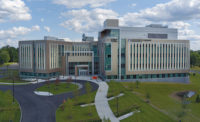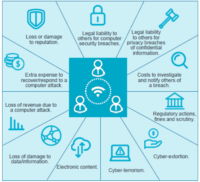...facing each other along a “cold aisle.” Hot air is exhausted out the back to the “hot aisle”.
With hot aisle containment the idea is to capture and evacuate the hot air away from the equipment. Various fan and duct configurations are used to move the hot air into a return air plenum, Cronin explains.

Cold aisle containment methods, which are actually more efficient, seek to enclose the cold aisle with plastic strips akin to freezer curtains, doors and/or roofing systems over the racks to ensure the cold air is delivered to the equipment intakes. Meanwhile the enclosures prevent the hot air from circulating back to the cold aisle, instead routing it back to the air handlers.
In-rack cooling systems employ cooling coils mounted on the rear doors or tops of enclosed equipment cabinets. Hot air exhausted by the equipment is push through the cooling coils and the resulting cool air re-circulated within the cabinet. Air flow paths are shorter, since you are not moving air to CRAC (computer room air conditioning) units, resulting in less energy usage, Cronin says.
Syracuse University’s new $12.4 million, 12,000-sq.-ft. data center is feeding cooled water pumped through pipes beneath the raised floor to heat exchanger-equipped cooling doors on the server racks. “The water to air heat exchanger removes heat from the racks more efficiently,” says James Herr, president, VIP Structures, Inc., Syracuse, N.Y. “It is like a miniature refrigerator.”
Free cooling increases energy efficiency by using the ambient environment to reduce or eliminate mechanical cooling. Yahoo will cool its Buffalo data center using 100 percent outside air. Operable louvers on the data center’s sidewalls and equipment fans draw in outside air to cool the servers. Hot air exhausted by the equipment is vented out of top of the building through louvered roof cupolas.
“Estimates are that in cooler climates, air-side economizers can reduce electrical bills by as much as 33 percent,” says David Bonifacic, managing principal, New York-based WB Engineering.
A tri-generation system producing electricity, heating and cooling at Syracuse’s data center will consume 50 percent less energy than a comparable data center, Herr explains. The system employs 12 natural gas-fired microturbines generating AC and DC power, avoiding conversion losses. Waste heat from the turbines is used by two absorption chillers. During the winter, the waste heat produces hot water to heat an adjacent office building.
Modularity and Containerization Modular phasing is helping companies deploy capital more wisely. Rather than building a large data center and waiting for it to fill up, more companies are building data centers in stages to meet current usage, says Chris Strom, director of project development mission critical at Skanska.
Instead of 100,000-sq.-ft. of wide open white space, companies are building 10,000- to 20,000-sq.-ft pods, Deneny explains. “It’s easier to have the engineering to cool and power a smaller footprint.” Designing for modular growth increases energy efficiency and helps the overall redundancy of the facility since each pod has dedicated infrastructure.

TERENCE DENENY

DAVID BONIFACIC
Modular or prefabricated construction techniques are also catching on. Schafer believes modular construction will help drive down the cost of the data center construction process.
Containerized data centers are another emerging trend. All data center infrastructure, including servers, switch gear and mechanical equipment comes preassembled in a shipping container. Simply slide the container in place, connect it to chilled water supply and return lines, power and bulk communications and you are off and running, Cronin says.
Using metrics from Hewett-Packard, 40 containers are roughly the equivalent of 160,000-sq.-ft. of raised floor data center. “If I took those 40 containers and built them 4 high and 10 wide I would need a building 100-foot-squared,” Cronin explains. “Think of the cost metrics. I’m going from a 160,000-sq.-ft. structure to a cube 100-ft.-sq. x 50-ft. tall.”

CHRIS STROM

JAMES HERR
Green Data Centers Beyond energy efficiency, companies are seeking green data centers. Syracuse’s new data center is designed to attain a LEED silver rating. Roughly half of Structure Tone’s clients are asking for LEED certification, Deneny says.
LEED certification is achievable for data centers but is more difficult than an office building due to resource usage, Pembrooke says. USGBC is currently working with a volunteer group of data center industry experts on a LEED 2009 adaption focused on revising selected credits to make LEED more accessible to data center projects.
BIM and IPD Building information modeling (BIM) and integrated project delivery (IPD) techniques are proving advantageous to data center design and construction. “BIM is advancing rapidly to where now we create the model, use it for clash detection and client orientation of the equipment and then tie into an electronic turnover package,” Cronin explains. All the data is integrated into an object oriented maintenance management system with real time alarms displays.
Clash detection found and resolved 1,400 conflicts and reduced the time for trade coordination by six-weeks on a $53-million 96,000-sq.-ft. data center project managed by Gilbane for an undisclosed client, Cronin says. Prefabrication of MEP components decreased field hours by an estimated 15 percent and mitigated congestion of materials and contractors on site.
Skanska is getting involved earlier, during the site selection process with data center projects. The site can determine the efficiency of the building, the cost of power and available tax incentives, Strom explains. “Companies are trying to make those first initial investment decisions in a more sophisticated manner and are trying to move very quickly. Whether it is an official IPD tri-party contract or not, it is really about a much more collaborative delivery.”


